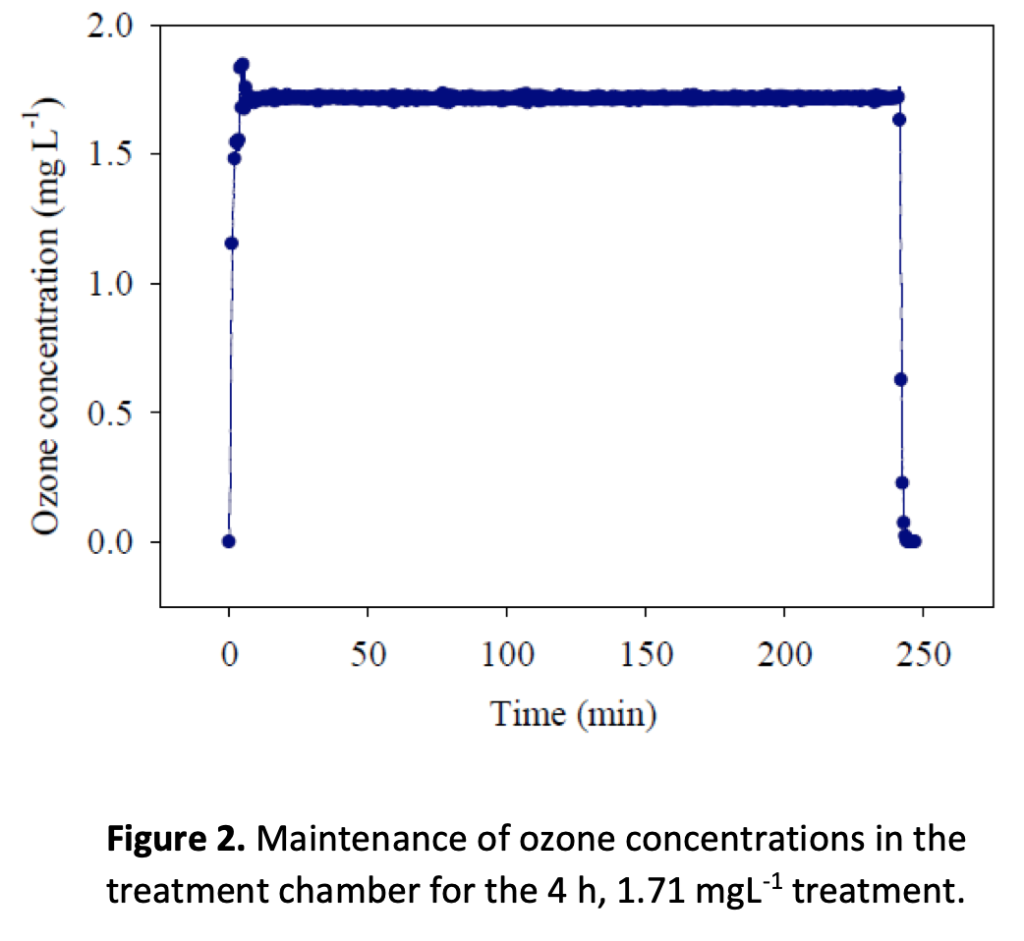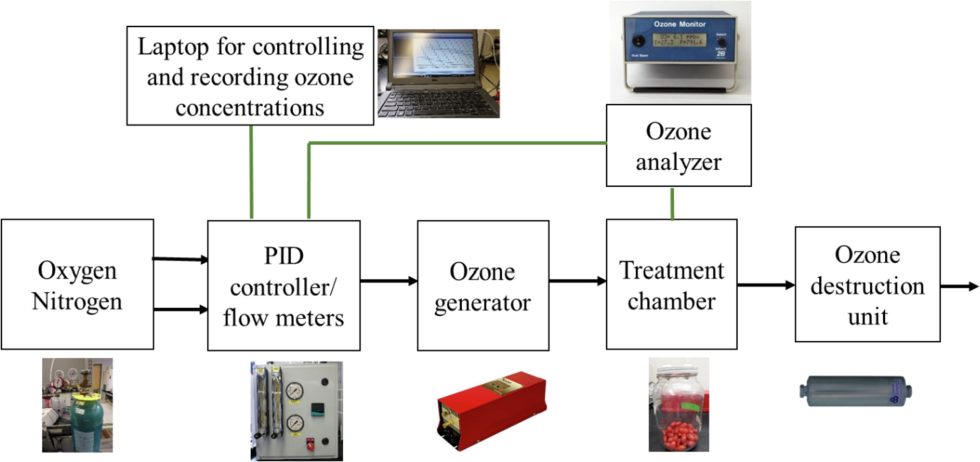
Impact of Elevated Ozone Treatment on the Safety and Quality of Grape Tomatoes
Frequently employed for fumigating fruits and vegetables, ozone serves as a means to diminish the presence of pathogens responsible for foodborne illnesses. In this investigation, the Model 106-MH was utilized to observe the application of ozone on grape tomatoes for the purpose of deactivating Salmonella, yeasts, and molds. While these treatments led to a decline in Salmonella and the populations of indigenous microbiota, there were associated trade-offs in multiple quality parameters and the nutrient content of the tomatoes.
The Challenge:
The United States is experiencing a rising trend in the consumption of fresh produce, but unfortunately, this surge is paralleled by an increase in the occurrence of foodborne illness outbreaks. Between 2004 and 2012, there were 377 reported outbreaks of foodborne illnesses associated with the consumption of produce in the United States. These outbreaks were attributed to pathogens such as Salmonella, Escherichia coli, and Listeria monocytogenes. In 2011, measures such as enhanced surveillance and improved pre- and post-harvest food safety practices were implemented, resulting in a decline in Salmonella outbreaks linked to tomatoes.
Ozone has been explored as a potential treatment method to mitigate the risk of future foodborne illness outbreaks. The FDA approved the use of ozone as a direct additive for food treatment in 2001, and both gaseous ozone and aqueous ozone are now commonly employed in the treatment of produce.
Researchers from the USDA’s Agricultural Research Service undertook a study to investigate the treatment of grape tomatoes using high ozone concentrations. The focus was particularly on the ozone's role in deactivating Salmonella, yeasts, and molds on the tomatoes. Additionally, the study observed the impact of ozone treatment on the sensory and nutritional quality of the fruit during a 21-day storage period at 10 °C.
The Resolution:
Tomatoes inoculated with Salmonella underwent exposure to ozone at concentrations of either 1.71 mgL-1, 3.43 mgL-1, or 6.85 mgL-1 for durations of 2 hours or 4 hours. Subsequently, the treated tomatoes were stored for 21 days at 10°C. Assessments of Salmonella populations, sensory attributes (including the detection of off-odors), total plate count (TPC), mold and yeast count, color, firmness, lycopene content, and ascorbic acid (vitamin C) content were conducted on days 1, 7, 14, and 21 of the storage period.
Salmonella inoculation was achieved by applying a 10 μl bacterial suspension to the stem scar or smooth surface areas of the tomatoes. To prevent runoff, aliquots of the inoculum were strategically placed at five locations on the smooth surface of the fruit. The ozone treatment setup for the tomatoes included an ozone generator (NANO, Absolute Ozone, Edmonton, Canada), an ozone monitor (106-MH, 2B Technologies, Boulder, CO, USA), a proportional integral device (PID), a one-gallon treatment jar, and an ozone destruct unit (Ozone Solutions, Hull, IA, USA). The gas mixture of oxygen and nitrogen from pressurized cylinders was regulated by the PID controller and ozone monitor to achieve the specified ozone concentrations in the treatment jar.
Outcomes:
Ozone treatment proved effective in diminishing Salmonella populations on grape tomatoes. The 2-hour and 4-hour treatments with 6.85 mgL-1 ozone led to approximately a 2-log reduction in CFU fruit−1 on both the smooth surface and stem scar areas of the tomatoes. However, the other ozone treatments (1.71 mgL-1 and 3.43 mgL-1 for 2 hours and 4 hours) did not exhibit a significant impact on Salmonella populations when compared to the control.
Notably, ozone treatments at concentrations of 6.85 mgL-1 for 2 hours and 4 hours, as well as 3.43 mgL-1 for 4 hours, resulted in a significant reduction in total plate count on both day 1 and day 7 of the storage period. Furthermore, the yeast and mold count experienced a significant decrease on day 7 of storage following the 4-hour ozone treatment with 6.85 mgL-1.

Various aspects of fruit quality were evaluated, revealing notable findings. Grape tomatoes treated with 3.43 mgL-1 ozone for 4 hours exhibited significantly lower appearance scores than the control on all sampling days, except for day 1. Moreover, the 4-hour treatment with 6.85 mgL-1 ozone significantly reduced the appearance scores of grape tomatoes on every sampling day, to the extent that tomatoes treated with both 3.43 mgL-1 and 6.85 mgL-1 ozone for 4 hours deteriorated to the point of being unsuitable for sale.
In terms of off-odor, fruit treated with 3.43 mgL-1 for 4 hours had significantly higher off-odor than the control on day 1 and day 14. Additionally, grape tomatoes treated with 6.85 mgL-1 for 4 hours exhibited significantly higher off-odor than the control on all sampling days.
The redness ratio, deemed acceptable by the USDA in the range of 0.95–1.21, fell below the threshold for fruit treated with 3.43 mgL-1 and 6.85 mgL-1 ozone for 4 hours on all sampling days.
All ozone treatments at concentrations of 3.43 mgL-1 and 6.85 mgL-1 resulted in significant reductions in the firmness of grape tomatoes, with a noticeable immediate loss of firmness.
Regarding biochemical composition, fruit treated with 6.85 mgL-1 ozone for 4 hours exhibited significantly lower lycopene content on day 1. Lower lycopene content was also observed in fruit treated with 3.43 mgL-1 ozone for 2 hours and 6.85 mgL-1 ozone for 4 hours on day 14. After 21 days of storage, fruit treated with 3.43 mgL-1 and 6.85 mgL-1 ozone for 4 hours displayed only one-third of the ascorbic acid content compared to the control.
In summary, elevated concentrations of gaseous ozone effectively decreased Salmonella populations on both the smooth surface and stem scar area of tomatoes, also leading to a reduction in native microbiota populations during the initial storage phase.
Nevertheless, the application of gaseous ozone treatments resulted in detrimental effects on tomato quality and nutritional content. These adverse impacts encompassed alterations in appearance, the onset of off-odors, softening, diminished redness, and a decline in ascorbic acid/lycopene content. Consequently, the utilization of high ozone concentrations for extended periods may not be suitable for enhancing the microbial safety of grape tomatoes without compromising the overall quality of the fruit.
The Role of the 2B Tech Instrument
The Model 106-MH Ozone Monitor played a crucial role in quantifying and regulating the ozone concentration employed to assess its impact on grape tomatoes. With its broad measurement range of approximately 0-21.41 mgL-1 (0-10,000 ppm), this instrument facilitated the control of all three distinct ozone levels utilized in the study. The two-level relays, featured in the Model 106-MH, were employed to govern the output of an ozone generator, ensuring a consistent and stable ozone level. This was imperative for exposing grape tomatoes to the precise ozone amounts needed, allowing researchers to accurately document its effects on the fruit. The compact size and portability of the Model 106-MH made it convenient to pair with the NANO ozone generator for the purposes of this study.
The Key Takeaway
If your needs involve monitoring ozone off-gas in a water treatment plant, managing lower concentration ozone generators, overseeing ozone in food treatment, or engaging in any research project or industrial application requiring ozone concentrations between 0-10,000 ppm, then the Model 106-MH Ozone Monitor is the ideal choice. The instrument is available in our distinctive blue bench-top enclosure (depicted on the left), in an industrial/NEMA wall-mount enclosure, or as an OEM if integration into your own system is preferred. With its exceptionally low power requirements and high portability, the instrument is versatile for various ozone-related projects and research studies. The previously mentioned two-level relays empower the instrument to regulate an ozone generator or trigger an external warning system in case ozone concentrations surpass a user-defined set point (refer to our Tech Note 45 for insights into applications of these relays). For further discussions on utilizing the Model 106-MH for your specific application, please reach out to 2B Technologies.










